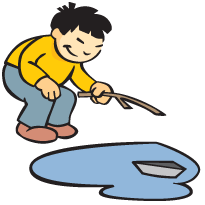Boston Children's Museum
308 Congress Street, Boston, MA 02210
617-426-6500
© Boston Children’s Museum 2024
Website Design by JackrabbitEven very young children can fold a sheet of aluminum foil into a shape that will float. Adapting the boat for improved performance requires a little more dexterity and an ability to observe and make conclusions about the materials and their functions. In addition measurement, record keeping and problem solving skills are all required in this simple activity.
Cut the foil into 8″ X 8″ squares. Make enough squares so that each team will have 3–4 to experiment with. Gather the pennies or washers, but make sure to use one or the other, not both. It is important that the weights all be consistent. If using washers, they should be 3/4″ or 5/8″ wide. Fill the bin or buckets with water, 6″–10″ deep.

Ask your students if they have ever been on a boat before. What are boats made of? If wood and metal are on the list, ask your students if wood and metal always floats. Show them the pencil and paper clip and ask them what they think will happen if you put them in water. Drop them into one of the buckets or the bin of water and ask your students for their thoughts on what happened. Point out that while metal usually sinks, there must be something about metal boats that make them float, and that they will all experiment by making small metal boats today.
Use the materials you’ve been given to create a boat that holds as much weight as possible.
After 10 minutes or so, when each team has begun testing their first designs, gather your students together to talk about what they have discovered so far. What are some of the shapes they have tried? Have teams hold up their boats or draw the shapes on a chalkboard or piece of chart paper. How much weight (how many pennies or washers) did these different shapes hold? Do some shapes seem to work better than others? Make sure to also ask each team how they are putting the weight into their boat. Are they stacking the weights all in the middle or spreading the weights out? Does this make a difference?
Send teams back to explore some more and try to make the strongest boat they can. Hand out more sheets of aluminum foil as needed. Near the end of the session, bring all the teams together again to share their conclusions.